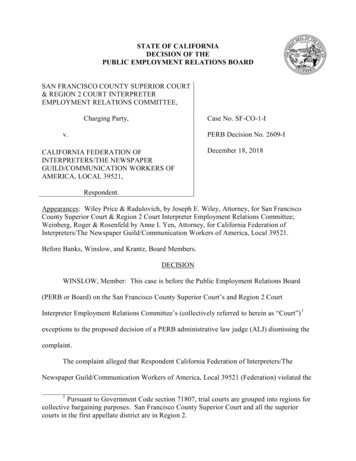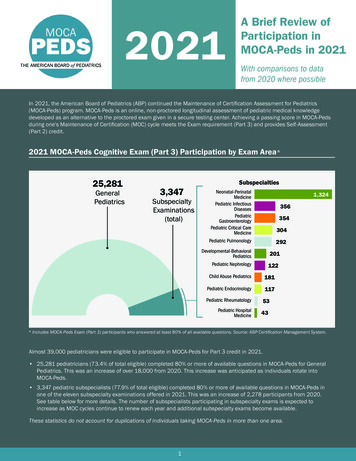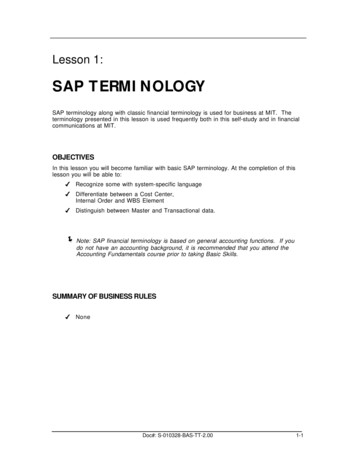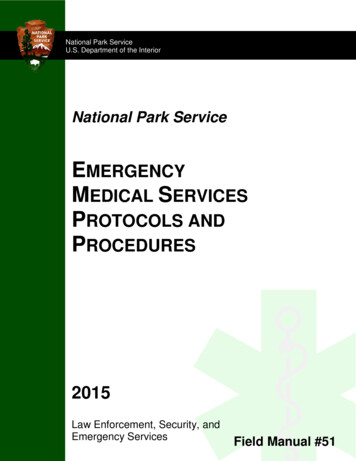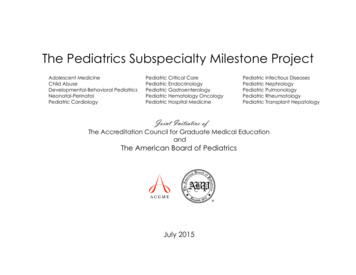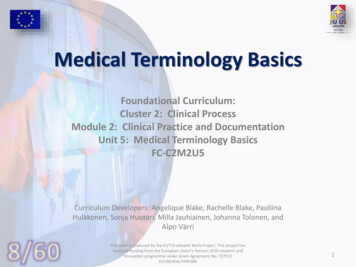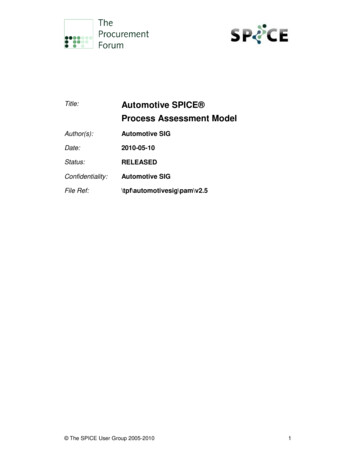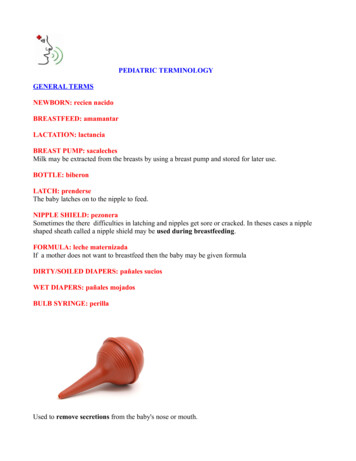
Transcription
PEDIATRIC TERMINOLOGYGENERAL TERMSNEWBORN: recien nacidoBREASTFEED: amamantarLACTATION: lactanciaBREAST PUMP: sacalechesMilk may be extracted from the breasts by using a breast pump and stored for later use.BOTTLE: biberonLATCH: prenderseThe baby latches on to the nipple to feed.NIPPLE SHIELD: pezoneraSometimes the there difficulties in latching and nipples get sore or cracked. In theses cases a nippleshaped sheath called a nipple shield may be used during breastfeeding.FORMULA: leche maternizadaIf a mother does not want to breastfeed then the baby may be given formulaDIRTY/SOILED DIAPERS: pañales suciosWET DIAPERS: pañales mojadosBULB SYRINGE: perillaUsed to remove secretions from the baby's nose or mouth.
PACIFIER: chupete o chuponCAR SEAT: asiento para niñosWIC (WOMEN, INFANTS & CHILDREN): WIC (mujeres, bebes y niños) is a federal assistanceprogram which provides healthcare and nutrition of low-income pregnant women, mothers and theirchildren under 5 years of age.NICU (NEONATAL INTENSIVE CARE UNIT).Babies may need to spend some time in NICU when they are having difficulty breathing or otherproblems. Especially the preterm babies.DROPPER: goteroBabies may be given liquids or medicines using a dropper.STROLLER: carriolaRASH: sarpullido
CHICKEN POX: varicellaViral infection characterized by a vesicular rash (blisters)MEASLES: sarampionViral infection characterized by a red skin spots.RUBELLA (aka GERMAN MEASLES OR 3-DAY MEASLES): rubeolaViral infection. Three day rash. Light red spots. Swollen lymph glands nape.SCARLET FEVER: escarlatinaRed body rash that can appear after strep throat infection.HAND-MOUTH-FOOT DISEASE: fiebre aftosa humanaHEAD LICE: pediculosisORTHOPEDICSMISALIGNED HIP: cadera dislocada/ luxadaThis implies a displacement of the femoral head from the place where it shoud normally be in thejoint causing a loss of function. It causes the child to limp and can be due to: hip dysplasia, a slippedcapital femoral epiphysis (SCFE) or Perthe's disease.HIP DYSPLASIA: displasia de caderaDue to degenerative changes in the head of the femur.SLIPPED CAPITAL FEMORAL EPIPHYSIS (SCFE): epifisiolisis de caderaDue to a fracture at the growth plate, a “slippage” of the femoral head occurs leaving it out of place.PERTHES' DISEASE: enfermedad de Perthes: due to deficient blood supply, the femoral headdoesn't develop well, becoming too small to bear the weight of the hip. Something like taking a carremoving it's normal wheel and replacing it with a motorcycle wheel!
GREENSTICK FRACTURE: fractura en tallo verdeChildren's bones are more flexible that an adult's so they tend to have incomplete fractures called“greenstick fractures”.CLUBFOOT: pie zamboIs a foot deformity where the foot is deviated inwards and downwards so that the only part of thefoot that makes contact with the floor is the ball of the foot (like a horse hoof).MUSCULAR DYSTROPHY: distrofia muscular : is a group of genetically transmitted disorderscharacterized by progressive weakness and muscle fiber degeneration without nerve damage. Theonset of muscular dystrophy is early in life. Duchenne's and Becker's are forms of musculardystrophy.MUSCLE BIOPSY: biopsia de musculoEither a needle or an incisional biopsy can be used to diagnose muscle diseases like musculardystrophy.CPK LEVEL: examen de creatina fosfoquinasaCPK stands for Creatinine Phosphokinase and is an enzyme whose levels increase in musculardystrophy.
CARDIOLOGYTETRALOGY OF FALLOT: tetralogia de FallotCongenital heart malformation that includes 4 defects: Stenosis of the pulmonary artery Ventricular septal defect Aorta shifted to the right (causing it to receive blood from both ventricles when it should onlyreceive blood from the left ventricle) and Enlargement (hypertophy) of the right ventricle.PATENT DUCTUS ARTERIOSUS: ductus arterioso persistenteThe ductus arteriosus is a blood vessel that communicates the aorta and the pulmonary artery inthe fetus. It normally shrivels up at birth. When it fails to close we get what's known as a patent ductusarteriosus. More frequently seen in preterm babies.COARCTATION OF THE AORTA: coartacion de aortaCongenital heart defect characterized by a narrowing of the aorta.TRANSPOSITION OF THE GREAT VESSELS: transposicion de grandes vasosCongenital condition in which the 2 major arteries of the heart (the aorta and the pulmonary artery)are reversed in position (the aorta originating from the right ventricle and the pulmonary artery fromthe left ventricle). Baby turns blue after birth.VENTRICULAR SEPTAL DEFECT: comunicacion interventricularATRIAL SEPTAL DEFECTS: comunicacion interauricularThese last two conditions imply that there is a hole in the wall that separates the atria or the ventricles.
RHEUMATIC FEVER: fiebre reumatica: sometimes a child can develop a sore throat, a throatinfection called “strep throat” because it is caused by a bacteria called: Group A Steptococcus.After that throat infection an inflammatory, autoimmune response against the child's joints andheart can occur this is called rheumatic fever. It can cause serious damage to the heat valves and alsoaffect the brain causing chorea (see presentation on nervous system).RESPIRATORYENLARGED ADENOIDS: hipertrofia de adenoidesHypertrophy (enlargement) of the adenoids in young children may be great enough to interfere withthe child's breathing causing a snoring noisy sound when the child breathes.BRONCHIOLITIS: bronquiolitisInflammation of the small airways (bronchioles). Most frequently seen in babies (3-6 months old).RESPIRATORY DISTRESS SYNDROME (SDRA): sindrome de distres respiratorioCondition seen in preterm babies with immature lungs. A collapse of the alveoli creates a severeimpairment of respiratory function. Leading cause of preterm death.PERTUSIS (WHOOPING COUGH): tos ferinaCROUP (LARYNGOTRACHEOBRONCHITIS): crup (laringotraqueobronquitis)Respiratory infection that causes inflammation and swelling of the larynx with hoarseness, barkingcough, stridor and may interfere with normal breathing.STRIDOR: estridorHigh-pitched wheezing sound due to upper airway obstruction (inflammation of the larynx).EPIGLOTTITIS: epiglotitisInflammation of the epiglottitis with stridor. Emergency with may require intubation.
SUDDEN INFANT DEATH SYNDROME (SIDS): muerte infantil subitaCYSTIC FYBROSIS: fibrosis quistica o mucoviscidosisGenetic disease of the mucous and sweat glands where these glands produce abundant and thicksecretions. This mainly affects the lungs where the thick secretions interfere with the breathingprocess and predispose to infectionsDIGESTIVECLEFT PALATE: paladar hendidoCongenital defect where the right and left bony plates that form the roof of the mouth did not fuseduring fetal development leaving a fissure or opening in the palate.CLEFT LIP: labio LeporinoCongenital indentation in the upper lip.BOWEL OBSTRUCTION: obstruccion intestinalA form seen in children is called intussusception (the first 2 syllables of the word : IN-TU) help us toremember that what's basically happening here is that the small intestine folds “into” itself sort of likewhat happens when you close a telescope by sliding it's parts into each other.PYLORIC STENOSIS: estenosis piloricaCongenital narrowing of the stomach outlet which obstructs the emptying of the chyme into theduodenum.LACTOSE INTOLERANCE: intolerancia a la lactosaInabilty to digest milk, causes diarrhea.DIARRHEA: diarreaHas many causes. In children frequently caused by rotavirus.BRAT DIET: dieta Brat (dieta para la diarrea)BRAT stands for bananna, rice, apple, toastORAL REHYDRATION SALTS: sales de rehidratacion oralUsed to treat dehydration (diarrhea).ONCOLOGYACUTE LYMPHOBLASTIC LEUKEMIA (ALL): leucemia linfoblastica aguda : most frequentleukemia in children.BURKITT'S LYMPHOMA: linfoma de BurkittGLIOMAS: gliomaMEDULLOBLASTOMA: meduloblastomaGliomas and Medulloblastomas are brain tumors frequently located in the cerebellum.WILM'S TUMOR: tumor de Wilm's
Type of kidney cancer seen in children.NEUROBLASTOMA: neuroblastomaMost common cancer of infancy. Arising in nervous tissue, it can appear in different parts of a child'sbody.OSTEOSARCOMA: osteosarcomaBone cancer.HEMATOLOGYDIAMOND-BLACKFAN ANEMIA : anemia de Blackfan-DiamondInherited aplastic anemia with low RBC countFANCONI'S ANEMIA : anemia de FanconiInherited aplastic anemia with pancytopenia (counts of ALL blood cells are low)NEONATAL JAUNDICE: Some newborns are born with high bilirubin levels because their liver isstill working a little slow or due to hemolysis. Lights help lower the bilirubin levels.UROLOGYEPISPADIAS: epispadiasBirth defect where instead of the urethra opening at the tip of the penis it opens on the upperside ofthe penis.HYPOSPADIAS: hipospadiasIs a birth defect where instead of the urethra opening at the tip of the penis it opens on the undersideof the penis.PHIMOSIS: fimosisMeans that the uncircumcised foreskin is too snug, can't be pulled back.CRYPTORCHIDISM: criptorquidiaMeans that one of the testicles didn't make it down to the scrotum. Remember we had said that inthe fetus the testicle is located in the abdomen. This condition needs to be corrected surgicallybecause the testicle that is still up inside is at increased risk to develop testicle cancer.VOIDING CYSTOURETHROGRAPHY (VCUG): cistouretrografia miccional (CUGM)Urinary study done in children with recurrent UTI to see if they have ureteral reflux.NEUROLOGYSPINA BIFIDA : espina bifidaSpina bifida is a neural tube defect. The neural tube is an embryological structure from which thebrain, spinal cord and spinal column derive. Spina bifida occurs when the one or more vertebrae donot form completely (the posterior vertebral arches fail to close) thus leaving an opening in thevertebral spine through which elements of the spinal cord can protrude. This may result in legweakness or paralysis.
SPINA BIFIDA OCCULTA: espina bifida ocultaThe defects in the vertebrae are so small that no elements of the spinal cord can protrude.Sometimes a tuft of hair is present in the skin above the defect.SPINA BIFIDA CYSTICA: espina bifida quisticaIf what protrudes into the cyst is only meninges then it is called a: MENINGOCELE: meningoceleIf what protrudes into the cyst is meninges and spinal cord then it is called a: MENINGOMYELOCELE: mielomeningoceleCEREBRAL PALSY: paralisis cerebralA collective term used to describe congenital brain damage that is permanent but not progressive andcharacterized by a child's lack of control of voluntary muscles.HYDROCEPHALUS: hidrocefaliaCongenital disorder with abnormal increase of cerebrospinal fluid in the brain that causes thecerebral ventricles to dilate. Infant will have a large head and open fontanelles.
FONTANELLES: fontanelas (mollera-coloquial term)Soft spots on a baby's skull where skull bones are not yet calcified permitting brain and skull togrowABSENCE SEIZURES (PETIT MAL): crisis de ausenciaCharacterized by small seizures in which there is a sudden, temporary loss of consciousness lastingonly seconds but recurring 50-100 times a day. Blank stare during seizure.VALPROIC ACID: acido valproicoUsed to treat absence seizuresFEBRILE SEIZURE: convulsion febrilPOLIOMYELITIS (POLIO): poliomielitis (polio)EARBRAINSTEM AUDITORY EVOKED RESPONSE (BAER TEST): potenciales evocadosauditivos del tronco cerebral (PEATC)Because a baby or child are too young to undergo an audiometry if it is suspected that they are hardof hearing they undergo a BAER test which does not require that they participate in the test for it to bedone. This test detects electrical activity in the cochlea and auditory pathways in the brain. Test isdone by placing electrodes on scalp and earlobes.
PSYCHIATRYAUTISM: autismoImpaired social interaction and communication. These are children who fail to develop normalsocial behaviors and show stereotyped behavior like hand flapping. They seem to live in their ownworlds. Some of them are less impaired and have a high functional autism known as :ASPERGER'S SYNDROME: sindrome de AspergerATTENTION DEFICIT HYPERACTIVITY DISORDER (ADHD): trastorno de deficit deattencion e hiperactividad (TDAH): disorder characterized by persistent excessive inattention andhyperactivity. These kids can't stay still or focus on something for long. Bad grades at school call toit's attention.Thank you for choosing InterpreterPrep.com!
RHEUMATIC FEVER: fiebre reumatica: sometimes a child can develop a sore throat, a throat infection called "strep throat" because it is caused by a bacteria called: Group A Steptococcus. After that throat infection an inflammatory, autoimmune response against the child's joints and heart can occur this is called rheumatic fever.It can cause serious damage to the heat valves and also
